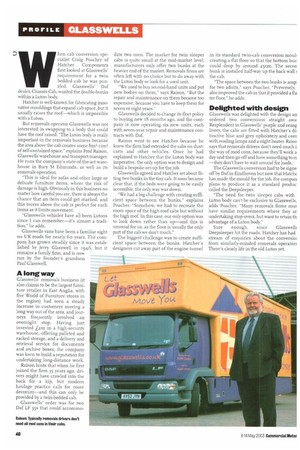IN hen cab conversion specialist Craig Poacher of Hatcher Components first
Page 40

If you've noticed an error in this article please click here to report it so we can fix it.
looked at Glasswells' requirement for a twin bedded cab he was puzzled. Glasswells' Daf dealer, Chassis-Cab, wanted the double-bunks within a Luton body.
Hatcher is well-known for fabricating innovative mouldings that expand cab space, but it usually raises the roof—which is impossible with a Luton, But removals operator Glasswells was not interested in swapping to a body that could have the roof raised. "The Luton body is really important in the removals business because the area above the cab creates some 8m3-11m3 of self-contained space," explains Fred Raison, Glasswells warehouse and transport manager. He runs the company's state-of-the-art warehouse in Bury St Edmunds, as well as its removals operation.
"This is ideal for sofas and other large or delicate furniture items, where the risk of damage is high. Obviously in this business no matter how careful you are, there is always the chance that an item could get marked, and this recess above the cab is perfect for such items as it limits movement.
"Glasswells vehicles have all been Lutons since I can remember—it's almost a tradition," he adds.
Glasswells vans have been a familiar sight on UK roads for nearly 6o years. The company has grown steadily since it was established by Jerry Glasswell in 1946, but it remains a family firm, and is now run by the founder's grandson Paul Glasswell.
A long-way
Glasswells' removals business (it also claims to be the largest furnihire retailer in East Anglia, with five World of Furniture stores in the region) had seen a steady increase in customers moving a long way out of the area, and journeys frequently involved an overnight stop. Having just invested 12m in a high-security warehouse, offering palleted and racked storage, and a delivery and retrieval service for documents and archive boxes, the company was keen to build a reputation for undertaking long-distance work.
Raison hints that when he first joined the firm 35 years ago, drivers might have crawled into the back for a kip, but modern haulage practice calls for more decorum—and this can only be provided by a twin-bedded cab.
Glasswells' order was for two Daf LF 555 that could accommo date two men. The market for twin sleeper cabs is quite small at the mid-market level: manufacturers only offer two bunks at the heavier end of the market. Removals firms are often left with no choice but to do away with the Luton body or look for a used unit.
"We used to buy second-hand units and put new bodies on them," says Raison, "But the repair and maintenance on them became too expensive, because you have to keep them for seven or eight years."
Glasswells decided to change its fleet policy to buying new 18 months ago, and the company is now operating six new units, each with seven-year repair and maintenance contracts with Dal Raison went to see Hatcher because he knew the firm had extended the cabs on dustcarts and other vehicles. Once he had explained to Hatcher that the Luton body was imperative, the only option was to design and build a bespoke set-up for the job.
Glasswells agreed and Hatcher set about fitting two bunks in the tiny cab. It soon became clear that, if the beds were going to be easily accessible, the only way was down.
"We had a big challenge with creating sufficient space between the bunks," explains Poacher. "Somehow, we had to recreate the room space of the high-roof cabs but without the high roof. In this case, our only option was to look down rather than up—and this is unusual for us, as the floor is usually the only part of the cab we don't touch."
The biggest challenge was to create sufficient space between the bunks. Hatcher's designers cut away part of the engine tunnel
in its standard twin-cab conversion mouli creating a flat floor so that the bottom bur could drop by around 25cm. The secon bunk is installed half-way up the back wall I the cab.
"The space between the two bunks is amp for two adults," says Poacher. "Perversely, also improved the cab in that it provided a fla ter floor," he adds.
Delighted with design
Glasswells was delighted with the design an ordered two conversions straight awa Resplendent in Glasswells' purple and orang livery, the cabs are fitted with Hatcher's di: tinctive blue and grey upholstery and corn with reading lamps and a night heater. Raiso says that removals drivers don't need much i the way of mod cons, because they'll work a day and then go off and have something to ez —they don't have to wait around for loads.
The Glasswells conversion had to be signe off by Daf in Eindhoven but now that Hatche has made the mould for the job, the compan plans to produce it as a standard produc called the Deepsleeper.
"The need for twin sleeper cabs with Luton body can't be exclusive to Glasswells, adds Poacher. "Many removals firms mw have similar requirements where they ar undertaking stop-overs, but want to retain th advantage of a Luton body."
Sure enough, since Glasswells Deepsleeper hit the roads, Hatcher has had stream of enquiries about the conversiol from similarly-minded removals operators There's clearly life in the old Luton yet.
































































































































































